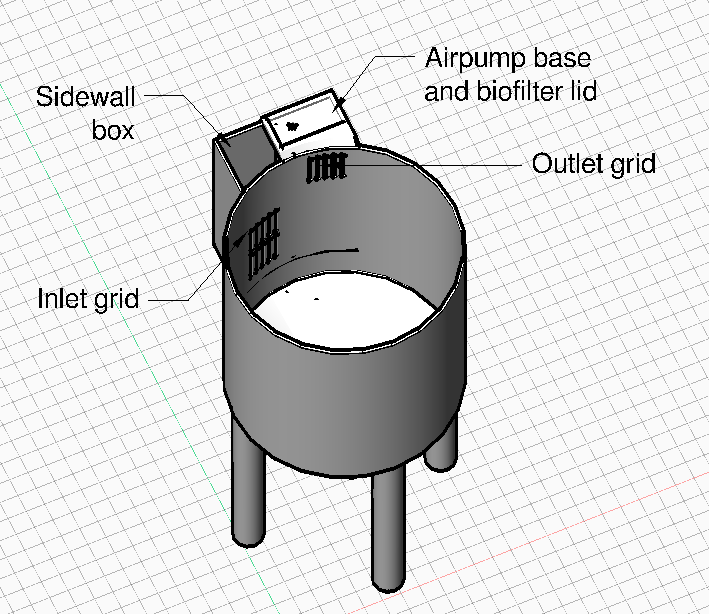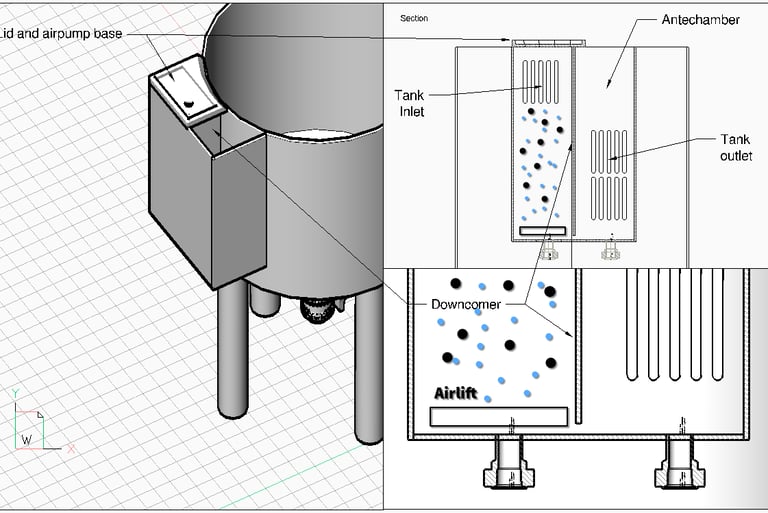Descentrialising RAS unit processes to lower CAPEX - some design notes and practical commentary. Part 1
This is the first of a 3-part series where I explore the concept of having RAS or hybrid RAS processes attached to each rearing unit, instead of having pods of tanks connected to filtration modules. In this first part, I explore the design concept in low-loading rearing units, such as broodstock tanks and tanks used in aquaculture research.
Carlos
10/20/20253 min read


I spent some days over the past couple of weeks working on a design concept based on a challenge posed by a researcher and friend of mine. They needed, on a tight budget, to run experiments with 12 fish tanks, each of them independently connected to their own RAS. Having spent the last decade designing and supplying RAS for labs and pilots, I understood the problem: sometimes you need the latest and greatest, some times you need it simple and low cost. Sometimes, you want to emulate a commercial RAS, some others, applying the three R's, you need very little.
I also reflected in what makes these small RAS costly. The easy answer is "everything", the more nuanced answer is that often automation, design, project management and labor to bring everything to life take a good fraction of the project's budget. There are some inescapable realities we must deal with:
1) Hoping to cut design effort to lower costs results in design effort that must be done during the construction phase, causing delays. However, sometimes leaving it to en experienced builder or pipefitter to figure out a solution might speed things up. A lesson here is to communicate with fabrication teams during the design phase to take their advice into consideration and have them ready for what's coming.
2) Pipework is costly. In small piping projects, the cost of design and installation far outweight the cost of the materials. Reducing or eliminating a piping project is more about reducing labour costs than buying less plastic.
3) My own bane: procurement and logistics. Even a small project will be handling hundreds of parts from dozen suppliers and nothing ever goes smoothly, especially when supply chains for a single, custom project aren't established.
4) Onsite construction can become costly very fast: having people on site and moving them back home, accomodation, extra bonuses and extra hours. This can be minimized by sending ready-made, plug and play systems to the customer. But, this can also be almost eliminated by sending the client the sytems in kit form, so they can put it together by themselves with little effort. The ornametal fish industry is a great example of this.
So what did I come up with? I took inspiration from the work done by Steve summerfelt and his team on sidewall airlifts for production tanks. The concept is that an airlift, installed on the tank wall, can provide circulation, aeration and carbon dioxide stipping in hybrid RAS and RAS. I take this concept a step forward: if the airlift can be filled with random biomedia, it can provide some ammonia removal, too. This only works in lightly loaded tanks, otherwise, the biomedia requirements would make the entire airlift arrangement disproportionally large.
Therefore, in lighly loaded tanks, the dissolved oxygen requirements can also be met by the airlift arrangment. Thus, except for solids removal, a biomedia-filled airlift can, in theory, provide gas exchange, biofiltration and water circulation to a lighlty loaded rearing tank. This eliminates the need for pipework connecting unit processes, and, in the hand of a good builder, provide a plug and play, hybrid RAS solution.
Adding other unit processes such as solids treatment or temperature control is straightforward. Settable solids can be simply flushed out of the bottom drain of the tank, which is particularly useful in fish nutrition studies. Suspended solids can be removed by protein skimmers, installed in the sidewall airlift antechamber. Temperature control can be achieved with coil exchangers or submersible heaters also installed here. If external processes are isntalled, such as bead filters or chillers, these can be connected to the sidewall box and discharge either back on the sidewall box or as a "velocity assist" vertical spraybar inside the tank.
In conclusion, this design provides a self-contained solution powered by an airpump, that can provide the water quality needed in a research tank with minimal installation effort. The capacity to control the cost of such units is largely down to the cost of fabrication, the cost of the air handling equipment and protein skimmer. Must-haves such as monitoring systems and emergency oxygenation can be easily added.
In Part 2, I will explore this concept applied to a commercial producion tank.
If you want to explore how to implement these designs, drop me an email!


ChimanaTech
Chimana Management BV
Hemelrijk 2A
5281PS
Boxtel
The Netherlands
carlos@chimana.tech
+31 612 769 754
© 2025. All rights reserved.
